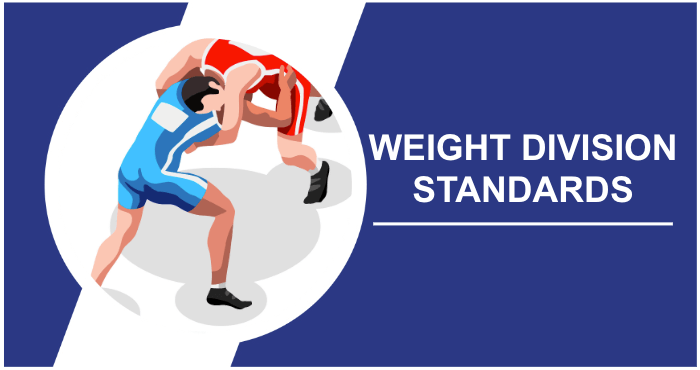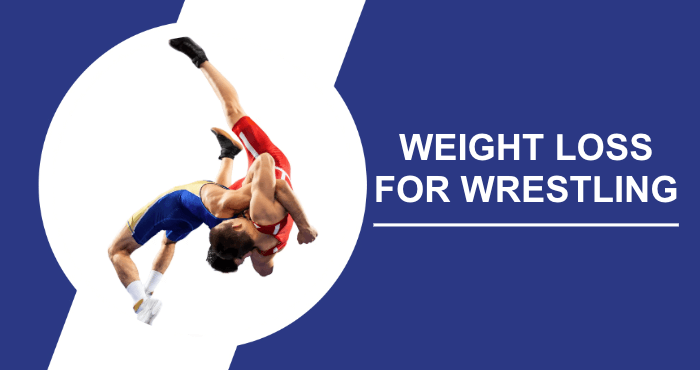Are you a grappler looking for weight loss strategies to compete in a lighter weight class? Maybe you’re looking to shed a few pounds while maintaining your muscle mass and power. Gradually reducing body weight to compete in a lower weight class can increase your strength and improve your competitiveness. However, many wrestlers approach weight loss with unhealthy practices that can leave them feeling weak and exhausted. Read on to discover common tactics wrestlers use to lose weight, how to diet effectively, and which techniques to avoid.
How To Lose Weight For Wrestling Some wrestlers assume that losing weight quickly will help them perform better in a lower weight class at critical weigh-ins. However, they often adopt unhealthy approaches to weight loss that can actually weaken their strength and negatively impact their performance. Here are 8 strategies to help wrestlers safely shed a few pounds while maintaining their ability to triumph on the mat.
What Is Wrestling?
Wrestling is a combat sport that incorporates grappling techniques such as clinches, throws, takedowns, joint locks, and pins. The goal is to gain and maintain a superior position over an opponent. It is one of the oldest forms of combat, with a rich history in various cultures. Wrestling is also a popular part of the Olympic Games.
8 Guidelines For Healthy Weight Loss In Wrestlers
Here are eight guidelines to help wrestlers lose weight safely and effectively while maintaining their ability to excel in competition.
1. Start Gradually
A common pitfall for many wrestlers is setting unrealistic weight loss goals that make success difficult. Begin by aiming to lose 1-2 pounds per week, gradually increasing to 2-3 pounds. Research shows that slow, steady weight loss promotes better maintenance of muscle mass and strength than rapid weight loss.
Plan to reach your target weight about a week before the official weigh-in and calculate the time it will take to reach it. If you start by losing excess weight, you risk losing valuable muscle mass as well as fat.
2. Continue Your Fitness Regimen
Continue your strength training routine; it’s important to stay fit and prevent muscle loss, especially after you’ve gained muscle during the off-season. Continuing to train while reducing body fat should gradually decrease your overall weight.
Training in the off-season and off the mat is critical to increasing strength and improving endurance. It’s important to match your training intensity with dietary adjustments to ensure steady weight loss. Stay hydrated after training with another wrestler to replenish fluids lost during training.
3. Eat A Nutritious And Balanced Diet
Eat three nutritious meals a day. Start your morning with a carbohydrate-rich breakfast of whole grain cereal, a banana, and whole wheat bread spread with a little peanut butter, accompanied by some skim milk and fresh orange juice.
A well-rounded lunch might consist of whole-grain bread or pita, a serving of lean protein, and a variety of vegetables, such as lettuce and tomatoes. You should also include a serving of fruit and low-fat yogurt. A suitable dinner might include high-protein lean meat or shrimp sauteed in vegetable oil, a variety of vegetables, and a bowl of brown rice. You might add a dash of low-sodium soy sauce for flavor.
4. Reduce Fat Consumption
Like the energy demands of wrestling matches and training sessions, wrestlers require a great deal of energy and burn a significant amount of calories intensely. Therefore, it’s best to reduce your intake of fatty foods while still maintaining a high caloric intake. Aim to get the majority of your meal’s calories from foods rich in carbohydrates and protein. These nutrients replenish muscle glycogen and help repair and build muscle tissue and fibers.
5. Rest And Quality Sleep
It’s important to take breaks between training sessions. Schedule a day of rest each week to allow your muscles to relax, recover, heal, and grow. A regular sleep schedule of 7-8 hours per night is beneficial to your health. Be mindful of the timing of your wrestling sessions in relation to your sleep schedule, as late training can disrupt your deep and REM sleep phases. For better sleep quality and muscle recovery, be sure to get plenty of downtime before bedtime.
6. Eat More Consistently Throughout The Day
Eating meals at consistent times throughout the day can help control hunger and increase metabolism. This practice can also help prevent overeating. Eating a snack within 30 minutes of a wrestling session or match is beneficial for muscle recovery and growth. These replenishing snacks should provide about 100-200 calories and ideally include protein, carbohydrates, and some fat.
Healthy snack options include a small serving of unsweetened cereal with nonfat milk or ten whole grain crackers with a slice of cheese. Energy bars and protein shakes are also great choices during these times or when you’re experiencing a sudden drop in energy.
7. Nibbling On Healthy Foods
These snacks are different from those consumed after a workout or workout and consist only of high-carbohydrate, low-fat items or fruit. Choose pretzels over sugary snacks like candy or chips. Watch the sodium content of snacks. Sodium causes the body to retain excess water, so avoid foods high in sodium, especially in the days leading up to a weigh-in.
8. Maintain Hydration
A common mistake made by athletes, including wrestlers, is attempting to lose water weight through fluid restriction and excessive sweating. This approach leads to dehydration, which causes headaches and muscle weakness. To ensure peak mental and physical performance, consume plenty of water.
Aim to drink water every 10-15 minutes during exercise and at least every few hours during the day. Avoid caffeinated beverages such as coffee and tea, which act as diuretics and increase dehydration. Increasing water intake in the weeks leading up to a weigh-in is beneficial because it helps suppress appetite by keeping your stomach fuller longer.
Weight Division Standards

A pre-match weigh-in is usually held at least one hour prior to a wrestling match to ensure that each competitor is in their designated weight class. Wrestlers often experience slight weight gains during the off-season, usually accumulating a few extra pounds over their initial season weight.
In American high school wrestling, each prospective wrestler is subject to assessments enforced by the National Federation of State High School Associations. These assessments measure body fat percentage and hydration levels to determine the athlete’s physical condition.
The organization has the authority to prevent wrestlers from reducing their weight beyond a certain limit at weigh-ins. This protocol is designed to mitigate the negative effects of excessive weight loss in high school wrestlers.
How Much Weight Is Safe To Cut Before A Wrestling Match?
The safe amount of weight to cut before a wrestling match varies based on individual factors such as body composition and hydration levels. In general, losing 1-2% of body weight per week is considered safe. Rapid weight loss can lead to decreased strength, endurance, and cognitive function.
It’s important to focus on losing fat, not muscle or water, and to maintain proper hydration and nutrition. Consultation with a healthcare professional is recommended for personalized guidance. Wrestlers should prioritize health and safety over drastic weight loss.
Losing Body Fat Through Intense Calorie Reduction
Many wrestlers attempt to shed pounds quickly by drastically reducing their caloric intake, often resulting in malnutrition. A wrestler generally requires a higher caloric intake than non-athletes due to the demanding nature of their sport, which requires energy for the synthesis and repair of muscle tissue.
Some wrestlers resort to the extreme of inducing vomiting before a weigh-in in order to qualify for a particular weight class. Undernutrition that causes rapid weight loss can reduce muscle mass and trigger both anxiety and depression. Wrestlers who are attempting to lose weight should ensure that they are getting enough essential vitamins and minerals.
Intense caloric restriction combined with dehydration is a disastrous combination. Wrestlers using these two methods of weight loss may experience a deterioration in muscle strength, endurance, and cognitive abilities.
Losing Weight Through Dehydration
Research shows that up to 67% of athletes in weight sports, such as wrestlers, often reduce their water intake to lose weight quickly. This approach involves restricting significant amounts of fluid both during exercise and throughout the day. In fact, water restriction can lead to water weight loss. However, this comes at the cost of reduced performance in competition, as well as decreased cognitive function, strength, and endurance.
Signs of dehydration can appear quickly and cause feelings of fatigue and sluggishness. Symptoms of mild dehydration include
- Headache
- Dizziness
- Dry mouth
- Nausea
With extreme fluid restriction, you may experience more severe symptoms, such as
- Shock due to low blood volume
- Swelling of the brain
- Heat exhaustion, often due to overexertion
To determine if you’re dehydrated, look at the color of your urine. Properly hydrated urine appears light or clear, while dark, apple-juice-colored urine indicates dehydration.
Are There Any Side Effects?
Cutting weight for wrestling often involves rapid weight loss techniques that can lead to several side effects. These include dehydration, decreased muscle strength, decreased endurance, and possible nutritional deficiencies. It can also affect mental focus and mood. More serious consequences may include metabolic imbalances, hormonal imbalances, and an increased risk of injury.
Long-term effects can include eating disorders and altered growth in younger athletes. It’s important for wrestlers to approach weight management carefully and with professional guidance to minimize health risks.
Avoid These Weight Loss Methods
Occasionally, a wrestler may reach a plateau at a certain weight. However, using dangerous weight-loss tactics can harm your health and impair your athletic performance.
Research shows that consistent use of unhealthy weight loss techniques can lead to numerous health problems. These include decreased muscle strength and athletic performance, diminished mental and cognitive abilities, mood swings, and changes in our immune response. Inadvisable weight loss strategies include:
1. Restricting Food Intake
A diet that restricts your food intake to a few calories a day is harmful. Aim for a balanced diet with reasonable portions spread evenly throughout the day. Prolonged fasting may cause nausea, severe fatigue, or dizziness.
2. Using Excessive Sweating Techniques
The use of impermeable clothing, such as sauna outfits or garbage bag tops, relies on water loss and is not a safe approach to weight loss. This technique causes excessive sweating and overheating, and while you may lose weight quickly, it’s only water loss that leads to more dehydration.
3. Eliminating Carbohydrates And Proteins
Some wrestlers may avoid carbohydrates and proteins to put their bodies into ketosis, burning fat for energy instead of glucose. However, consuming adequate amounts of both nutrients is essential to maintaining strength and endurance.
4. Abuse Of Laxatives Or Diuretics
Laxatives and diuretics should not be used to lose weight. Misuse can lead to serious health problems, including electrolyte imbalances, irritable bowel syndrome, and damage to the kidneys and liver.
How Can I Effectively Rehydrate And Refuel After Weigh-In?
To effectively rehydrate and refuel after a weigh-in, start by taking small, frequent sips of an electrolyte-rich beverage to restore hydration levels. Gradually increase fluid intake over the next few hours. To refuel, consume easily digestible carbohydrates such as fruit, smoothies, or sports drinks to quickly replenish energy stores.
Add protein-rich foods such as yogurt or a protein shake to aid in muscle recovery. Avoid large meals and high-fiber foods initially to prevent gastrointestinal discomfort. It’s also important to listen to your body’s signals and hydrate and eat accordingly.
Frequently Asked Questions
What is wrestling weight cutting?
Weight cutting in wrestling refers to the practice of losing weight, primarily through fluid loss, in order to qualify for a lower weight class in a wrestling competition. It’s a common practice among wrestlers to gain a perceived advantage over lighter opponents.
What are effective weight loss methods?
Effective and safe methods include gradually reducing caloric intake, increasing water intake and decreasing it closer to the weigh-in, and increasing training intensity. Avoid extreme measures such as dehydration or starvation.
What foods should I eat to lose weight?
Focus on nutrient-dense, low-calorie foods such as lean proteins, vegetables, fruits, and whole grains. These provide essential nutrients and help maintain energy levels while reducing caloric intake.
Can dehydration methods be used to lose weight?
Although dehydration methods such as saunas or sweat suits are commonly used, they can be dangerous. It’s important to stay hydrated for health and performance. Any loss of fluid should be minimal and closely monitored.
How can I maintain strength while losing weight?
To maintain strength, focus on consuming high-quality protein, keeping your workouts consistent, and making sure you get enough rest. Weight loss should be gradual to avoid loss of muscle mass.
Conclusion
Achieving an optimal balance between diet and exercise is critical to weight loss and maintaining lean muscle. Hydration is key, so be sure to drink plenty of water during exercise and throughout the day. Eat three nutritious meals with plenty of protein, significant carbohydrates, and minimal fat. It’s important to replenish energy with a nutritious snack after exercise.
It is important to plan your weight loss gradually over time and avoid losing more than 2-3 pounds per week. It’s recommended that you reach your goal weight one week before your weigh-in, as rapid weight loss can be detrimental to your health and interfere with the exercise necessary to lose weight, build strength, and improve endurance. In addition, avoid quick weight loss tactics that rely on dehydration or the elimination of entire food groups.
Overall, losing weight to enter a lower weight class can improve your performance by providing a more favorable strength-to-weight ratio, but it’s important to do so slowly and in a healthy manner.
Sources
- Reale, R., Slater, G.J., & Burke, L.M. (2017). Acute-Weight-Loss Strategies for Combat Sports and Applications to Olympic Success. International Journal of Sports Physiology and Performance, 12(2), 142–151. Read Article.
- Carl, R.L., Johnson, M.D., Martin, T.J., LaBella, C.R., Brooks, M.A., Diamond, A., Hennrikus, W., LaBotz, M., Logan, K., Loud, K.J., Moffatt, K.A., Nemeth, B., Pengel, B., & Peterson, A. (2017). Promotion of Healthy Weight-Control Practices in Young Athletes. Pediatrics, 140(3). Read Article.
- Garthe, I., Raastad, T., & Sundgot-Borgen, J. (2011). Long-Term Effect of Weight Loss on Body Composition and Performance in Elite Athletes. International Journal of Sport Nutrition and Exercise Metabolism, 21(5), 426–435. Read Article.
- Alghannam, A.F., Gonzalez, J.T., & Betts, J.A. (2018). Restoration of Muscle Glycogen and Functional Capacity: Role of Post-Exercise Carbohydrate and Protein Co-Ingestion. Nutrients, 10(2), 253–253. Read Article.
- Grillo, A., Salvi, L., Coruzzi, P., Salvi, P., & Parati, G. (2019). Sodium Intake and Hypertension. Nutrients, 11(9), 1970–1970. Read Article.
- Saidi, O., Davenne, D., Lehorgne, C., & Duché, P. (2020). Effects of timing of moderate exercise in the evening on sleep and subsequent dietary intake in lean, young, healthy adults: randomized crossover study. European Journal of Applied Physiology, 120(7), 1551–1562. Read Article.
- Woodroffe, L., Donnenwerth, J., & Peterson, A.C. (2016). Weight Management Counseling for Wrestling Athletes. Journal of Athletic Training, 45(3). Read Article.
- Evans, G.H., James, L.J., Shirreffs, S.M., & Maughan, R.J. (2017). Optimizing the restoration and maintenance of fluid balance after exercise-induced dehydration. Journal of Applied Physiology, 122(4), 945–951. Read Article.
Jayson Peterson is an experienced pharmacist, naturopathic physician, medical examiner, and minister. After earning his Doctor of Pharmacy degree from the Medical University of South Carolina, Jayson Peterson completed clinical rotations at several prestigious healthcare institutions and has been affiliated with several pharmacy chains throughout his career. His main passion and zeal is focused on providing world-class patient care by giving precise details and thorough instructions to those who need it most.

